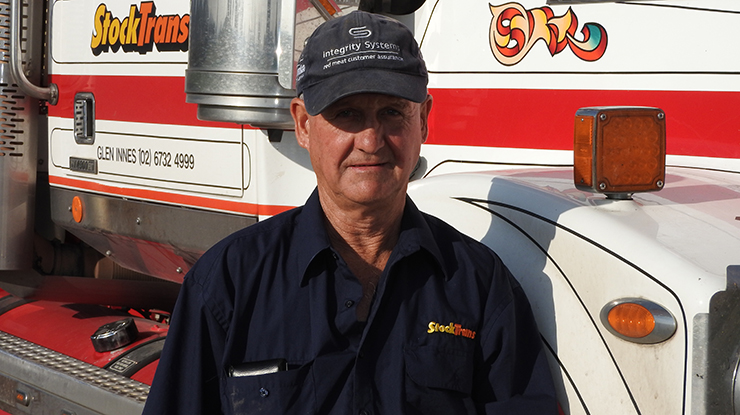58 logbooks and a lifetime of truck driving
15 March 2024
 Graham Sharman, Professional Driver, StockTrans – Glen Innes NSW
Graham Sharman, Professional Driver, StockTrans – Glen Innes NSW
Trucks and livestock have been part of Graham Sharman’s life for as long as he can remember.
“I started out when we were kids. My twin brother and I grew up on our grandfather's dairy farm. We used to do a cream run with him, then I'd go in the truck with him as a four-year-old,” Graham said.
Spending time with his stepfather, a tow truck driver and life on the family place at Glen Innes meant Graham continued his involvement with trucks, cattle, sheep, horses and goats.
His career as a professional driver began in 1980 with Graham working in NSW and Queensland and moving into livestock carting in 2000 for a company out of Casino.
Now on his 58th logbook, Graham joined the StockTrans team in 2005 and said he appreciates the well-maintained, clean fleet of trucks they provide.
“I’ve been well looked after since I’ve been here. I make suggestions and they listen.
“They’re willing to listen. It’s that simple,” Graham said.
Preparation and adequate yard time essential
In his role with StockTrans, Graham covers northern NSW and southern Queensland loading and unloading an average of 300–500 cattle each week and covering between 3,000–4,000km.
Making sure cattle are fit for the journey and yarded 10–12 hours ahead of the trip are important points for producers to remember, Graham said.
“I went down to a bloke’s place recently and drove in and there was nothing in the yard.
“I rang the office to check I had the right day and time. I couldn’t see anyone. Then a motorbike came over the hill.
“The bloke jumps off and says, ‘Oh they’re up in the paddock up the back there I’ve just got to go and get them.’
“This was 8:30 in the morning. Those animals should really be yarded the night before and put on good quality dry hay and clean water.
“First job of the day and it put me behind by an hour all day. Often this is not the only job I’m doing for the day. We go and do another one or maybe two jobs after that.”
Cattle loaded straight from the paddock are a risk as they make a mess of themselves and the truck and aren’t as settled, Graham said.
“Good preparation for transport is everything and it makes my job easy and it is best for the animals too.”
Experience counts
Respecting the driver’s experience is also important when it comes to loading, he said.
“We load, unload and drive trucks as our profession, we do it six days a week with different types of cattle and loading facilities.
“Sometimes producers will say load it this way, and we say ‘it’s not going to fit, mate’ or ‘that won’t work, that animal won’t travel.’
“We do it virtually every day of the week, day in day out. It is about what is best for the animals and our clients,” Graham said.
Graham said the majority of people he deals can provide accurate weights and numbers at the time of booking the truck.
“Our office explains how many you can put on. Years ago, people would try and get an extra one in each pen – not anymore,” Graham said.
Early decision making
Graham recalls times in the drought where producers would sometimes wait too long to sell cattle which meant they weren’t strong enough to load and travel.
“Instead of booking the truck three weeks ago, they’re trying to move animals that are having difficulty walking up the ramp and are falling over. They’re not travelling anywhere.”
Being on the front foot and making the necessary decisions early enough can be tough but is something producers can discuss with transporters.
“Call up the office and discuss the best preparation strategies with our operations team to get those animals strong enough for me to load and get them off your farm either to agistment, direct sale or processing,” Graham said.
Keep calm and carry on
Getting on well with people, a professional attitude and keeping a cool head has led to a lot of repeat business and positive feedback to the office about Graham’s performance.
“Every now and then someone will say ‘You can send that bloke back here any time.’”
Driving positive change
Continual improvements across livestock and transport facilities makes the job more comfortable and safer for everyone.
“Driving hours are better now. They’ve got satellite tracking in all our trucks and updated cattle crates with bigger pens that are safer for us to operate and better for the animals. I believe they load and travel better in the bigger pens,” Graham said.
Trucks equipped with better seating, air conditioning in beds in the cab and better, wider roads all make driving a more enjoyable experience for transport operators.
“It’s the combination of the people you meet, working with animals, sunrises and sunsets. I just love the driving.”


